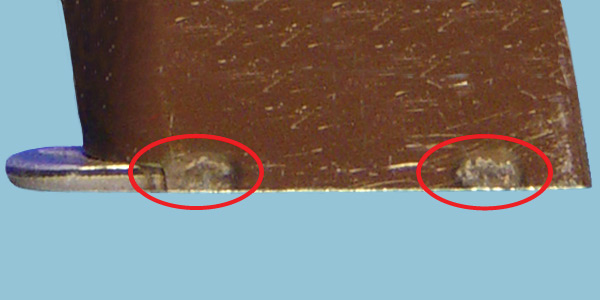Home | Glossary | Resources | Help | Contact Us | Course Map
Archival Notice
This is an archive page that is no longer being updated. It may contain outdated information and links may no longer function as originally intended.
AFTE Range of Conclusions
Based on the AFTE Theory of Identification, there are four categories of examination outcomes (Range of Conclusions Possible When Comparing Toolmarks) typically used by examiners in the microscopic comparison of both striated and impressed toolmarks.
For purposes of this module, typical toolmark comparisons fall into two broad categories:
- An evidence toolmark from a crime scene is identified as having been made by a particular evidence tool.
- Two evidence toolmarks recovered from the same or separate crime scenes are identified as having been made by a single tool (no tool submitted).
These categories are accepted for all types of toolmarks:
- Identification
- Inconclusive
- Elimination
- Unsuitable for comparison
Identification
The AFTE Glossary defines an identification as:
Agreement of a combination of individual characteristics and all discernable class characteristics where the extent of agreement exceeds that which can occur in the comparison of toolmarks made by different tools and is consistent with the agreement demonstrated by toolmarks known to have been produced by the same tool.
This statement reflects the concepts of sufficient agreement and best known nonmatch. All identifications are based on pattern matching. It is possible to go beyond this qualitative match to the use of quantifiable consecutive matching striae (CMS) to further support an identification.
Inconclusive
An inconclusive result is noted in the AFTE Glossary as the outcome of a comparison in which there is
- some agreement of individual characteristics and all discernable class characteristics, but insufficient for identification,
- agreement of all discernable class characteristics without agreement or disagreement of individual characteristics due to an absence, insufficiency, or lack of reproducibility,
- agreement of all discernable class characteristics and disagreement of individual characteristics, but insufficient for an elimination.
Elimination
As defined in the AFTE Glossary, elimination is a significant disagreement of discernable class characteristics and/or individual characteristics. For purposes of toolmark comparisons, an elimination is most often based on observed differences in any class characteristic.
However, an elimination based on individual characteristics is more complex. Conceptually, an elimination based on individual characteristics means that if a tool can be shown to have never been subjected to significant use or abuse over a period of time, the qualitative aspects of the marks produced on similar surfaces should remain the same. A difference in these qualities indicates an elimination.
Elimination based on individual characteristics requires a detailed knowledge of the history and treatment of the firearm, as well as documentation to support the history. It is the responsibility of the examiner to provide this historical documentation. This type of elimination should be approached with caution. Many experienced examiners have never made such an elimination, and the protocols of many laboratories do not allow it.
Unsuitable
The AFTE Glossary designates this category as unsuitable for comparison. This outcome is appropriate for evidence items that do not bear microscopic marks of value for comparison purposes or are so small or fragmentary as to have no value.
Examples of toolmarks that may be unsuitable for microscopic comparison:
- Saws and files generally leave toolmarks in which the particulate material falls away from the object that was cut. Each subsequent action removes the toolmark created by the previous action.
- Abrasive tools (e.g., grinding wheel or sandpaper) create individual marks on a surface. The tool changes (wears) with each rotation or stroke, eliminating any chance for an identification.
Additional Online Courses
- What Every First Responding Officer Should Know About DNA Evidence
- Collecting DNA Evidence at Property Crime Scenes
- DNA – A Prosecutor’s Practice Notebook
- Crime Scene and DNA Basics
- Laboratory Safety Programs
- DNA Amplification
- Population Genetics and Statistics
- Non-STR DNA Markers: SNPs, Y-STRs, LCN and mtDNA
- Firearms Examiner Training
- Forensic DNA Education for Law Enforcement Decisionmakers
- What Every Investigator and Evidence Technician Should Know About DNA Evidence
- Principles of Forensic DNA for Officers of the Court
- Law 101: Legal Guide for the Forensic Expert
- Laboratory Orientation and Testing of Body Fluids and Tissues
- DNA Extraction and Quantitation
- STR Data Analysis and Interpretation
- Communication Skills, Report Writing, and Courtroom Testimony
- Español for Law Enforcement
- Amplified DNA Product Separation for Forensic Analysts




